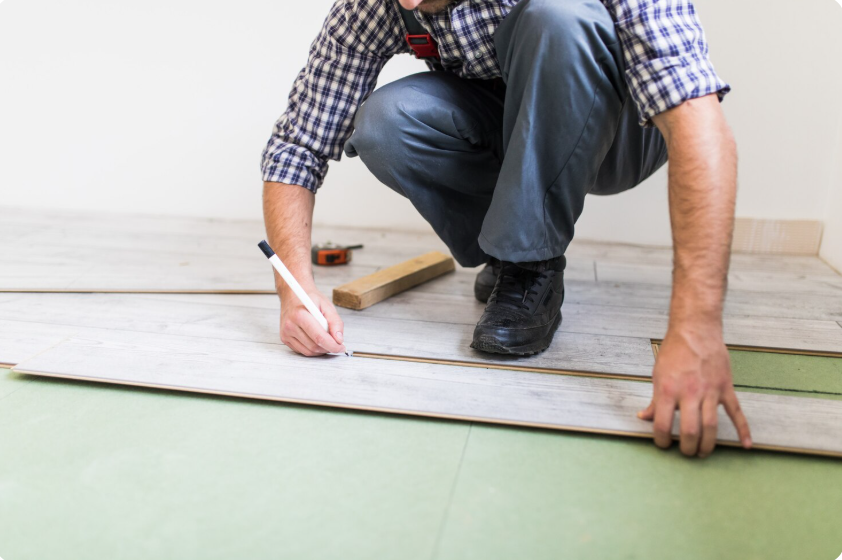Hardwood floors are a timeless addition to any home, bringing warmth, elegance, and durability. Over time, however, even the finest hardwood flooring can lose its luster due to scratches, stains, or general wear and tear. Refinishing your hardwood floors is a cost-effective way to restore their original beauty without the expense of a complete replacement. However, hardwood floor refinishing is a delicate process that requires careful planning and execution. Mistakes made during refinishing can lead to uneven finishes, permanent damage, or costly repairs. In this article, we will explore the common mistakes to avoid during hardwood floor refinishing and provide tips to achieve a professional-quality finish.
Whether you are considering hardwood floor refinishing in Burbank or anywhere else, understanding these pitfalls can save you time, money, and frustration.
1. Skipping Proper Preparation
One of the most frequent mistakes homeowners make during hardwood floor refinishing is neglecting proper preparation. The success of a refinishing project depends heavily on the groundwork laid before sanding or applying any finish.
Common preparation mistakes include:
-
Not removing furniture and obstacles: Attempting to refinish a floor with furniture still in the room can damage both the furniture and the floor. Clear the room completely before starting.
-
Ignoring cleaning: Dust, dirt, or debris on the floor can get trapped under the finish, leading to a rough texture or bubbles.
-
Failing to repair damages: Cracks, gaps, or loose boards should be addressed before refinishing. Refinishing over damaged floors can make these issues worse.
Proper preparation ensures a smooth and flawless finish. It also prevents the frustration of having to redo the work later due to avoidable errors.
2. Using the Wrong Sandpaper Grit
Sanding is a critical step in hardwood floor refinishing. It removes the old finish and prepares the wood for a new coat. However, using the wrong sandpaper grit is a common mistake that can permanently affect the appearance of your floors.
Key considerations include:
-
Starting too coarse: While coarse sandpaper is effective for removing old finishes, starting with a grit that’s too coarse can leave deep scratches that are difficult to hide.
-
Skipping grits: Sanding typically requires a progression from coarse to medium to fine grit. Skipping grits can result in uneven surfaces and visible sanding marks.
-
Using worn-out sandpaper: Dull sandpaper won’t remove the old finish effectively and can lead to inconsistent sanding.
Professional hardwood floor refinishing in Burbank often emphasizes the importance of following the correct sanding sequence to ensure a smooth and even surface.
3. Ignoring Dust Control
Sanding hardwood floors generates an enormous amount of dust. One of the most overlooked mistakes during refinishing is failing to control dust.
Why dust matters:
-
Uneven finish: Dust can settle on the floor while applying stain or polyurethane, resulting in a rough or speckled finish.
-
Health hazards: Inhaling fine dust particles can irritate the respiratory system.
-
Time-consuming cleanup: Dust can get everywhere, including walls, furniture, and fixtures, creating a significant cleanup burden.
Tips for dust control:
-
Use a professional-grade sander with a vacuum attachment.
-
Seal off the room with plastic sheeting to prevent dust from spreading.
-
Wear a dust mask and protective eyewear for safety.
4. Applying Stain or Finish Too Quickly
Rushing the staining or finishing process is another frequent mistake. Hardwood floor refinishing requires patience and attention to detail. Applying stain or polyurethane too quickly can lead to blotchy or uneven results.
Common errors include:
-
Overlapping strokes: Going over the same area repeatedly can cause streaks or uneven coloring.
-
Not allowing adequate drying time: Each coat of stain or finish needs sufficient time to dry before applying the next. Skipping or shortening drying times can trap moisture and result in a sticky or cloudy finish.
-
Uneven application: Applying too much or too little finish can create patches of high gloss or dull areas.
A professional hardwood floor refinishing process involves careful application, often using a brush or applicator designed for smooth and even coverage.
5. Choosing the Wrong Finish
Selecting the appropriate finish is critical for the durability and appearance of your hardwood floors. Many homeowners make the mistake of choosing a finish based solely on aesthetics without considering the floor’s usage and location.
Types of finishes and their considerations:
-
Oil-based polyurethane: Durable and provides a rich amber tone but takes longer to dry and has a stronger odor.
-
Water-based polyurethane: Dries faster, has a clearer finish, and is low in VOCs but may require more coats.
-
Hardwax oils: Penetrate the wood and enhance natural grain, providing a more natural look, but require periodic maintenance.
Choosing the wrong finish can reduce the floor’s longevity and require refinishing sooner than expected. Experts in hardwood floor refinishing in Burbank often help homeowners select the best finish for their lifestyle and décor.
6. Neglecting to Test Stain Color
A common mistake that can ruin the aesthetic appeal of hardwood floors is failing to test the stain color before full application. Wood species absorb stain differently, and the final color may not match your expectations.
Tips for testing stain:
-
Apply the stain to a small, inconspicuous area of the floor.
-
Observe the color after it dries, as it can change slightly during the drying process.
-
Adjust the application method or choose a different stain if the result is unsatisfactory.
Testing stain first can prevent costly mistakes and ensure your hardwood floors achieve the desired look.
7. Overlooking Edge and Corner Work
While large open areas of a floor are relatively easy to sand and refinish, edges and corners often require special attention. One of the most common mistakes during refinishing is neglecting these areas.
Why edges and corners matter:
-
Uneven sanding near walls can create visible high or low spots.
-
Missed areas may result in inconsistent color or finish.
Solutions:
-
Use a hand sander or edging tool for precision work.
-
Take extra time to ensure corners are sanded evenly before applying stain or finish.
Professional refinishing services always pay attention to edges and corners to achieve a seamless and uniform look.
8. Not Following Manufacturer Instructions
Every product used in hardwood floor refinishing, whether it’s sandpaper, stain, or polyurethane, comes with manufacturer instructions. Ignoring these guidelines is a frequent error that can affect the durability and appearance of your floor.
Why instructions matter:
-
Drying times and number of coats vary between products.
-
Some finishes require specific application methods for optimal results.
-
Incorrect use may void warranties.
Always read and follow the instructions for each product used during hardwood floor refinishing.
9. Skipping Maintenance After Refinishing
Refinishing your hardwood floors is not the final step. Proper maintenance is crucial to preserve the beauty and longevity of the finish. Many homeowners make the mistake of neglecting post-refinishing care.
Maintenance tips:
-
Clean floors regularly with a soft broom or vacuum.
-
Use damp—not wet—mops to avoid water damage.
-
Place protective pads under furniture legs to prevent scratches.
-
Avoid high heels or heavy shoes that can dent the floor.
Routine maintenance ensures that your refinished floors continue to look beautiful for years to come.
10. Attempting DIY Without Experience
While DIY projects can be rewarding, hardwood floor refinishing is a complex process that requires skill and experience. Many homeowners make the mistake of attempting to refinish floors themselves without adequate knowledge, leading to costly errors such as uneven sanding, blotchy stain, or damaged wood.
Hiring a professional for hardwood floor refinishing in Burbank can save you time, stress, and money. Professionals have the expertise, tools, and techniques to achieve a flawless result that will enhance your home’s value.
Conclusion
Hardwood floor refinishing is a transformative process that can bring new life to your home. However, it’s a task that requires careful planning, precision, and patience. Common mistakes—such as skipping preparation, using the wrong sandpaper, neglecting dust control, rushing stain application, and overlooking edges—can lead to disappointing results.
Whether you are tackling a refinishing project yourself or hiring experts, awareness of these pitfalls is essential. If you are considering hardwood floor refinishing in Burbank, working with experienced professionals ensures that your floors are restored to their full beauty with minimal risk of errors.
By avoiding these mistakes and following best practices, your hardwood floors can maintain their elegance, durability, and charm for decades. Hardwood floor refinishing is more than just a cosmetic upgrade—it’s an investment in your home that pays off in comfort, aesthetics, and property value.



